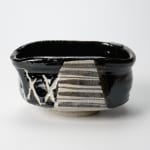Takiguchi Kiheiji 瀧口喜兵爾
H8 × W15 × D12.3 cm
Further images
-
(View a larger image of thumbnail 1
)

-
(View a larger image of thumbnail 2
)

-
(View a larger image of thumbnail 3
)

-
(View a larger image of thumbnail 4
)

-
(View a larger image of thumbnail 5
)

-
(View a larger image of thumbnail 6
)

-
(View a larger image of thumbnail 7
)

-
(View a larger image of thumbnail 8
)

Takiguchi Kiheiji (b. 1937) displays his distinctive Mino clay through traditional motif decorations. Born in Asakusa, Tokyo, he trained at the Kato Juemon Kiln between 1961 and 1965, before going on to establish his own Kiln Site in Oogaya and Kani City, just an hour away from each other, and where he is currently based. His work has been widely collected both in Japan and internationally.
In his black Oribe-glazed works, Takiguchi draws inspiration from the poetic forms of the Momoyama period, particularly from tea ceramics during this period. His frequent visits to museums in Japan inspired him to begin practicing the tea ceremony in his 30’s. Since then, his tea bowls have taken on a new sensitivity. The Momoyama period was also a time when black-glazed chawan were highly prized. His Black Oribe pieces possess a deep, pitch-black luster, reminiscent of polished black leather. This restrained yet sophisticated glaze has its roots in Korean ceramic traditions, introduced to Japan during the Momoyama period, and continues to embody the timeless elegance of classical Oribe ware.
Artist CV
Born in 1937 (Shōwa 12) in Tokyo
Graduated from Tamagawa University, Faculty of Agriculture, in 1960 (Shōwa 35)
Became an apprentice under master potter Katō Jūemon in 1961 (Shōwa 36)
In 2001 (Heisei 13), held the first father-daughter exhibition with his daughter, Asano.







